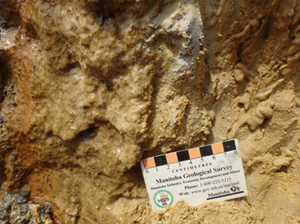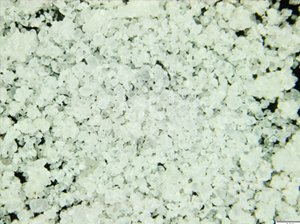Geoscience
Industrial Minerals
Commodity Summaries: Silica Sand
| Introduction The Winnipeg Formation is composed of some of the purest silica sand in North America occurring across southwestern Manitoba within the Williston Basin. This formation was deposited up to 480 Ma ago and is exposed in sparse outcrops along basinal edges in the south basin of Lake Winnipeg and in the vicinity of Flin Flon and Snow Lake. The Winnipeg Formation is composed of three members: the lower Black Island Member, the laterally discontinuous Carman Sand, and the upper Icebox Member. The Black Island Member and Carman Sand are composed primarily of unconsolidated sand and sandstone, and the Icebox Member is composed primarily of shale. Due to the poorly consolidated nature of the sand units, the Winnipeg Formation is notoriously difficult to drill with good core recovery, and outcrops are sparse and poorly exposed. The sands of the Winnipeg Formation have been identified as being of very high purity, with silica values exceeding 99.5%. The sands are very mature and are generally very well sorted, with individual grains being well-rounded and possessing frosted surfaces. Due to lateral facies variations across the Williston Basin, the quality of the sand as a source of silica can be variable. In places, the Black Island Member can have a high clay content, and the sand can be less mature, less well-sorted, and contain more impurities (such as pyrite, hematite, carbonates, etc.). Variations in the quality and characteristics of the sand impact its ability to be used for various industrial applications. The Carman Sand has not been quantitatively studied, but has been described as a high-quality sand to sandstone. Applications Historically, silica sand from the Winnipeg Formation has been used to produce glass. However, high purity silica sand has many high value or value-added applications. Silica sand from the Winnipeg Formation has been identified as a very high quality proppant for fracking. Proppants are an unconsolidated product utilized in tight oil and gas plays, where a relatively impermeable petroleum-bearing rock is artificially fractured. The resultant fractures, which act as conduits for fluid flow, are ‘propped open’ by the proppant, as pressure from overlying rock units would immediately close those fractures otherwise. |
Silica sand, Black Island quarry.
Unconsolidated silica sand, drillcore RP95-17. |
|
Other industrial applications of silica sand include, but are not limited to: • Foundry casting; • Ceramic production; • Refractories; • Enamel; • Glazes; • Silicon metal; and • Grinding and polishing. Deposits and Occurrences Historically, economic deposits of the silica sands of the Winnipeg Formation have been quarried from Black Island on Lake Winnipeg. At present Black Island is not being quarried and is no longer available for development. A small outlier of the Winnipeg Formation is located on mainland near Seymourville, southwest of Black Island. Silica sand is known to outcrop along some shorelines in the southern basin of Lake Winnipeg, specifically in Hecla/Grindstone Provincial Park. The Winnipeg Formation is known to also outcrop along the northern edge of the Williston Basin, between Athapapuskow and Wekusko lakes. A subsurface deposit of high purity silica sand has also been identified at the Victory Silica Minago property, north of Grand Rapids. Although the Winnipeg Formation located in the northernmost part of the Williston Basin has not been developed as of yet, coeval strata in Saskatchewan has been identified as potentially economical. The Winnipeg Formation occurs mostly continuously across the Williston Basin at variable depths and thicknesses. Drillcore across southwestern Manitoba has transected the Winnipeg Formation, where drilled deep enough. Suggested References Lapenskie, K. 2016: Preliminary investigations into the high-purity silica sand of the Winnipeg Formation, southern Manitoba; in Report of Activities 2016, Manitoba Growth, Enterprise and Trade, Manitoba Geological Survey, p. 176–180. McCabe, H.R. 1978: Reservoir potential of the Deadwood and Winnipeg formations, southwestern Manitoba; Manitoba Department of Mines, Resources and Environmental Management, Mineral Resources Division, Geological Paper GP78-3, 54 p. Vigrass, L.W. 1971: Depositional framework of the Winnipeg Formation in Manitoba and eastern Saskatchewan; in Geoscience Studies in Manitoba, A.C. Turnock (ed.), Geological Association of Canada, Special Paper 9, p. 225–234. Watson, D.M. 1985: Silica in Manitoba; Manitoba Energy and Mines, Geological Services, Economic Geology Report ER84-2, 35 p. |
||




